Books: english
Books: english

Confidences / Majority
The uprising was staged by the minority, and a downfall is remembered by the majority.
Gilgamesh “Gil” Gupta is a theatre maker and self-defined “avant-gardist.” As a young vampire, Gil’s alienation from time, body, and identity only increases with the murder of his sire, Patrice. Seasons pass in spite of this, and Gil endeavours to circumvent inter-species edicts to foster a meaningful audience. Recognition becomes a vocation.
Confidences / Majority is a novel that presents entertainment as critical gospel. Seething a trail of cultural debris, Majority is the second instalment in Ivan Cheng’s Confidences series, which deploys a version of the vampire and performance as sites for transformation and maintenance.
Ivan Cheng (b. 1991, Sydney) produces films, objects, paintings and publications as anchors for the staging of complex and precarious spectacles. His background as a performer and musician form the basis for his using performance as a critical medium and questioning publics and accessibility. He holds an MFA in Critical Studies from Sandberg Instituut; his work has recently been presented at Voiture14 (Marseille), La Maison Pop (Montreuil), Les Urbaines (Lausanne), Volksbühne Roter Salon (Berlin), Oude Kerk (Amsterdam), Belvedere21 (Vienna), MuHKA (Antwerp), Carriageworks (Sydney), Federation Square (Melbourne). In 2017 he initiated the project space bologna.cc in Amsterdam.
Confidences / Majority is published simultaneous to Cheng’s solo presentation Milieu at Édouard Montassut, Paris.

Supplication: Selected Poems of John Wieners
Supplication: Selected Poems of John Wieners gathers work by one of the most significant poets of the Black Mountain and Beat generation. Includes poems that have previously never been published, the full text of the 1958 edition of his influential The Hotel Wentley Poems, plus poems from rare sources, facsimiles, notes, and collages by Wieners. An invaluable collection for new and old fans.
John Wieners (1934-2002) was a founding member of the New American poetry that flourished in America after the Second World War. Upon graduating from Boston College in 1954, Wieners enrolled in the final class of Black Mountain College. Following Black Mountain's closure in 1956, he founded the small magazine Measure (1957-1962) and embarked on a peripatetic life, participating in poetry communities in Boston, San Francisco, New York, and Buffalo throughout the late 1950s and 1960s, before settling at 44 Joy Street in Boston in 1972. He is the author of seven collections of poetry, three one-act plays, and numerous broadsides, pamphlets, uncollected poems, and journals. Robert Creeley described Wieners as the greatest poet of emotion of their time.

4 Basic Kinds of Lines & Colour
On occasion of the Book as System exhibition, we are thrilled to publish a facsimile reprint of Sol LeWitt’s iconic Four Basic Kinds of Lines & Colour, co-published Printed Matter, Inc. & Primary Information.
Published in 1977 by Lisson Gallery, Studio International, and Paul David Press, the 34 page staple-bound book is an early example of LeWitt’s rigorous, algorithmic process in which a set of rules is run through its permutations to generate corresponding images. First in overview and then in detail, the publication sets down all possible combinations in overlaying four basic lines (vertical, horizontal, right-facing diagonal, left-facing diagonal) followed by a distinct combinatory system of four basic colors (yellow, black, red, blue).
Each spread is composed of these two parallel systems played out one at a time, with escalating line combinations on the left hand side and corresponding color combinations on the right. LeWitt’s Four Basic Kinds of Lines & Colour (1977) followed the publication of Four Basic Kinds of Straight Lines (Studio International, 1969) and Four Basic Colours and their Combinations (Lisson Gallery, 1971), and serves as a kind of synthesis of the two systems described in those earlier volumes.
Published by Printed Matter, Primary Information, 34 pgs, 20 × 20 cm, Softcover

My Life as a Godard Movie
Captivated by the liberated glamour of Jean-Luc Godard’s young stars as a teenager, Joanna Walsh rediscovers his films as an adult and finds herself resisting the temptation to identify with or desire the women on film. Instead, echoing Jean-Luc Godard’s pronouncement that ‘cinema is truth at 24 frames per second’, Walsh’s essay turns its gaze on the dynamics of the camera itself and demands a new kind of art. This is an experimental, bold, and wide-ranging book that refuses to setltle for easy answers. An essential read for anyone interested in women on film.

Hunters Follow Harpy Shadows
Hunters Follow Harpy Shadows is an experimental work featuring a series of poetic writings that explore fantasy narratives of rewritten mythologies. Mixing re-imagined trans Korean folklore, queered Biblical storytelling and pirate lore, the publication is an amalgamation of writing delivered from the lips of the artist as a genderfluid seraphim that has left heaven to tell mortals of the other worlds.
Across twenty-five chapters, Rin Kim’s text recounts the tangled, cosmic history of shapeshifting goddexes intermixed with an otherworldly cast of demis, dryads, wraiths, satyrs, tieflings and sirens. Taking cues from the Old Testament, fantasy storytelling, and the depths of fanfiction forums online, the project alternates between narrative storytelling in the direct mode of epic religious texts and a series of Psalmic interventions spoken in the innermost voice of the gods. Like a series of connected visions, Hunters Follow Harpy Shadows hands down the origin stories of distant worlds — of clashing immortals, species dying out, and deities fading from power. It is both a fantasy saga beset by violence, warfare and blood sacrifice, and a lovers’ song of longing and transcendence.
During the origins of the earth, mortals sacrificed their children to the belly of the depths, to Yawong: god of subservience and singularity…
Central to the project are new images by Oliver Davis, shot on 35mm film, which offer views of a fragmented landscape — jewel-like glimpses of sunlit trees, river stones, and murky underbrush. The lush world seen in these photographs, a version of earth devoid of all humans and figures, provides a quiet space outside of time for staging the mythic struggles of the gods. The book’s typography suggests perhaps an ancient document or illustrated manuscript; the sharp, secret lettering carrying the magic properties of a blade used to split worlds.
Design: Rin Kim
Photography: Oliver Davis
Editing: Olivia Ross
Production: The Uses of Literacy
Cloth-bound hardcover (Feincanvas), with cover tip-in and metallic foil stamping
Rin Kim, born in 1997 in Watertown, New York; is a multi-diciplinary trans chimera, demi, hydra, mutt, graphic designer, filmmaker, alchemist, performance artist, writer, and yong working around non-binary mythologies, ritual storytelling, and fantasy. Their work is a hyperfocused movement of a particular upheaval, an ongoing irruption that re-arranges every assumption of the equivalence of subjectivity and identity.
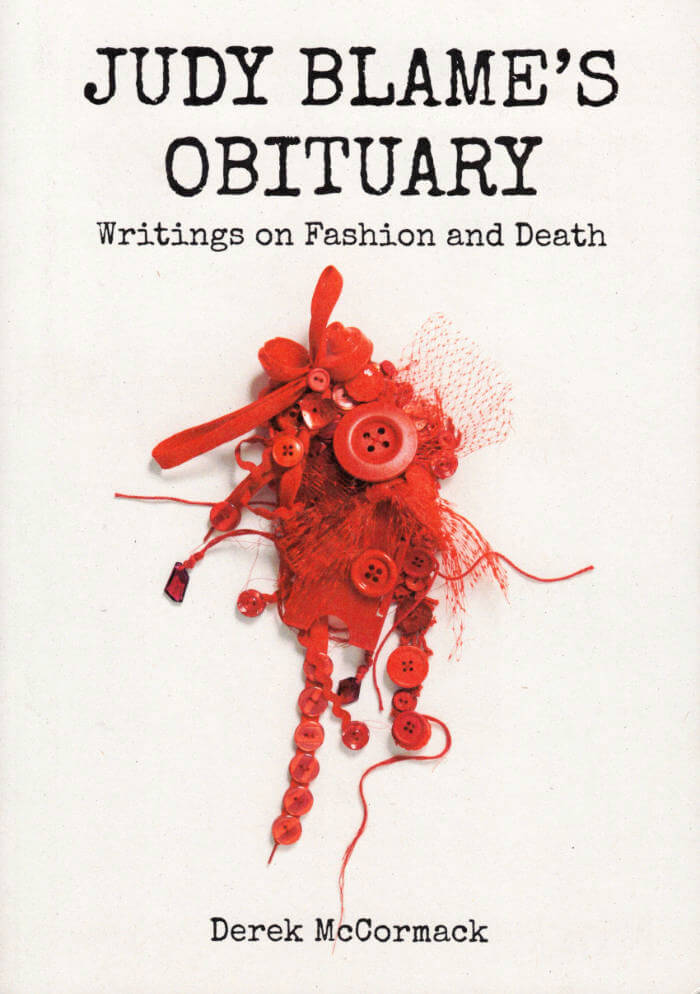
Judy Blame’s Obituary: Writings on Fashion and Death
Derek McCormack is the author of fashion-inflected novels that cast luminaries such as Elsa Schiaparelli and Balenciaga as characters. This collection brings together for the first time McCormack's fashion journalism. He writes about and interviews fashion figures that fascinate him, tracing the ways they inspire and inhabit his novels. The result is a sort of memoir in essays: as he writes, "My tribute to [Judy] Blame is about him and about me—there are lots of my own tales woven in with the topics I touch on. The writing here is a sort of autobiography, a life seen through a scrim, or a life as a scrim—my moire mémoire."
Judy Blame's Obituary contains twenty years' worth of reminiscences, reviews of fashion shows and books, interviews with writers about fashion, and interviews with fashion designers about writing. He talks to Nicolas Ghesquière about perfume, and to Edmund White about which perfume he wore as a young fag in New York City. He inspects the clothes that Kathy Acker left behind when she died, and he summons the spirit of Margiela in a literary seance. He traces the history of sequins, then recounts the cursed story of Vera West, the costume designer who dressed the Bride of Frankenstein. These pieces were all previously published, some in Artforum, some in The Believer, and some in underground publications like Werewolf Express—what binds them together is a sense that though fashion victimizes us, this victimization is sometimes a sort of salvation.
Derek McCormack is a Canadian writer. His most recent novels are The Well-Dressed Wound and Castle Faggot, both published by Semiotext(e). Of Castle Faggot, Dennis Cooper said: "It is really just one of the best books ever, and maybe the greatest novel ever written.
Praise for Judy Blame's Obituary:
'Derek McCormack, Canada's most famous author as yet unsullied by Nobel Prize or television adaptation, hides in plain sight as a fashion journalist. Parallel to his writing incantatory, scatalogical fiction, he has reviewed collections and interviewed the great and good of la mode. His divagations are often darkly hilarious and always exquisitely tailored. The sublime and the ridiculous coexist in his prose, as they do in life. Fashion victims, ignore his insights at your peril.' — William E. Jones
Published by Pilot Press, 20 × 15 cm, Softcover, 2021

Responses to Derek Jarman’s Blue
Responses to Derek Jarman's Blue is the third publication in a series of anthologies from Pilot Press seeking contemporary responses to works of art made during the AIDS crisis.
In this third iteration, responses were sought to the 1993 film Blue by the multidisciplinary artist Derek Jarman.
Contributors
In order of appearance
Roelof Bakker
Jared Davis
Becca Albee
Linda Kemp
Ashleigh A. Allen
David Nash
Sam Moore
Anton Stuebner
Gonçalo Lamas
Olivia Laing
Nate Lippens
Jason Lipeles
JP Seabright
Andrew Cummings
Sig Olson
Maria Sledmere
Cleo Henry
Jessie McClaughlin
Lars Meijer
Scott Treleaven
Declan Wiffen
Caitlin Merrett King
Harry Agius
António Manso Preto
Adriana Lazarova
Brooke Palmieri
D Mortimer
Mary Manning
Aaron James Murphy
Printed on 100% recycled paper
Published by Pilot Press, 20 × 15 cm, Softcover, 2022
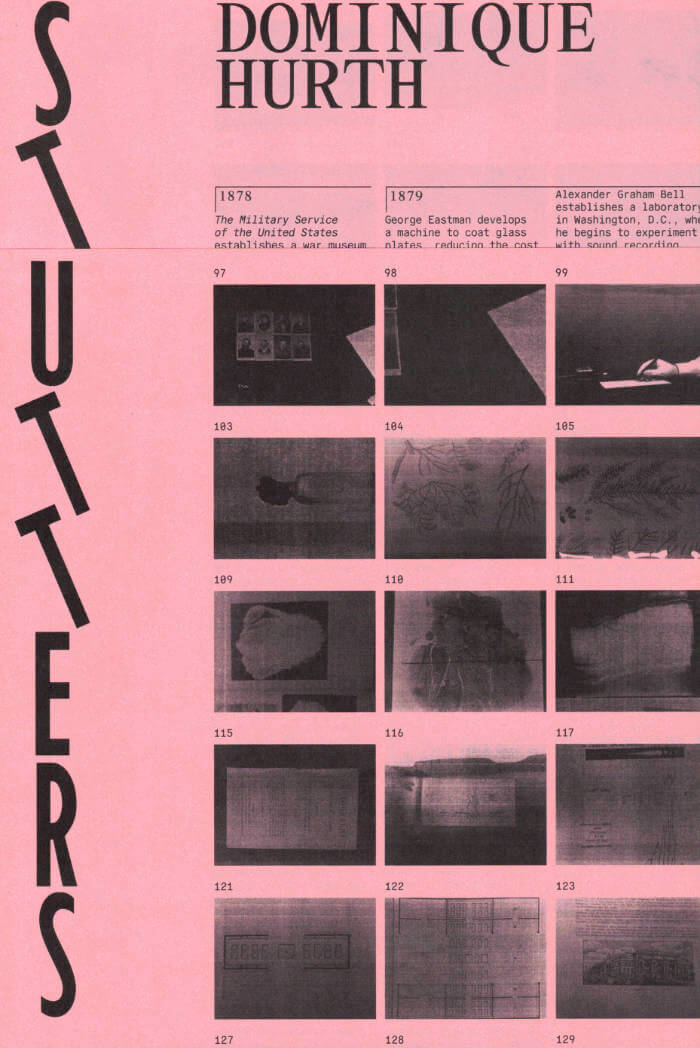
Stutters
In 2014, Hurth encountered four boxes of cyanotype prints by Thomas W. Smillie, the first custodian and curator of the Smithsonian Institution’s collection of photography (active 1868 to 1917). In her new work Stutters, Hurth builds on several years’ research to rework the original cyanotypes into visual montage, sequencing images that provide a record of Museum life as it documents a ‘national’ collection in the making. The work presents photographs of empty display cabinets and staged objects within the Smithsonian’s holdings, following divergent threads of photographic history, exhibitionship and collection-making, as well as developments in various technological apparatuses across the late 19th and early 20th century.
Through a meticulous process of xerox and printing reproduction, Hurth enlarges the world of each image and traces a photographic lineage, a process itself indebted to the cyanotype. Two overlapping sets of captions from the artist offer a subjective and scientific view of the photographs, inviting a cross-referencing of the “official”, if incomplete, bibliographic record with one that moves more freely across a historical timeline as a way to reflect on gaps in the archive.
Stutters includes three new texts, with Hurth considering the book’s entwined interests, as well as her own personal history with the Smithsonian and the work of Smillie. Additional contributions by authors and curators Ruth Noack and Kari Conte consider the ways in which artists’ projects like Stutters can quietly break apart the violent taxonomy of an archive, and instead use this shifting fragmentation to envision new meaning and bring into focus voices that have been excluded from history.
Dominique Hurth Born in France (1985), Dominique Hurth is a visual artist working with sculpture and installation, and within the relationship between sculptural matter and printed matter. Even though her installations are often concentrated on the form, a long and detailed research is strongly embedded in the development of this same form. It is by ways of archival research, journalistic investigation, writing and material experiments that the works develop, and it is by way of editing that the installation operates in the exhibition space. Her work was exhibited in several museums, galleries and institutions internationally (a.o. Palais de Tokyo, Paris; Hamburger Bahnhof, Berlin; Fundacio Tapies, Barcelona; Memorial of Ravensbrück, Fürstenberg/Havel; Württembergischer Kunstverein, Stuttgart) and is part of several collections. She is the recipient of several awards and residencies such as the Pollock-Krasner Foundation Grant (2016-17) and Prize of the Berliner Senate / Governing Mayor of Berlin at ISCP, New York (2014).

Bricks from the Kiln — Issue 4: On Translation, Transmission & Transposition
Andrew Walsh‐Lister, Matthew Stuart and 2 more
Bricks from the Kiln is an irregular journal edited by Andrew Lister and Matthew Stuart, sometimes with guest editors, that presents graphic design and typography as disciplines activated by and through other disciplines and lenses such as language, archives, collage, and more. It borrows its title from the glossary notes of Ret Marut’s "Der Ziegelbrenner," which was the ‘size, shape and colour of a brick’, and ran for 13 issues between 1917 and 1921.
The latest installment, "#4: On Translation, Transmission & Transposition," was published as an event (and now) a publication, with events at London College of Communication, Burley Fisher Books & Pig Rock bothy, Socttish National Gallery of Modern Art, and Inga (in November, 2019).
GREENING
Helen Marten
(front / back flaps)
JOY & HAPPINESS, FIDELITY
& INTIMACY IN TRANSLATION
Sophie Collins
(pp.4–13)
PLANETARY TRANSLATION
Don Mee Choi
(pp.15–19)
TRANSLATION AND A LIPOGRAM:
OR, ON FORMS OF AGAIN-WRITING
AND NO- (OR NOT THAT-) WRITING
Kate Briggs
(pp.23–33)
UNHOMING (1 of 4):
FOLLOWING HÖLDERLIN’S ‘HEIMAT’
Phil Baber
(pp.35–47)
SNOW WHITE AND THE WHITE
OF THE HUMAN EYEBALLS
Joyce Dixon
(pp.51–62)
ALTAMIRALTAMIRALTAMIRA
Florian Roithmayr
(pp.65–116)
LEVEL UP, LEVEL DOWN
Jen Calleja
(pp.119–124)
TRANS.MISSION [A.DIALOGUE]:
A JAVASCRIPT FOR THREE VOICES
J.R. Carpenter
(pp.127–134)
THE MECHANISATION OF ART
Edgar Wind
(glosses / annotations / insertions by
Natalie Ferris & Bryony Quinn)
(pp.137–144)
UNHOMING (2 of 4)
Phil Baber
(p.147)
COMMISSION FOR A NOIR MOVIE
B IN THE BAY OF BISCAY
Rebecca Collins
(pp.151–157)
UNHOMING (3 of 4)
Phil Baber
(pp.150–162)
EVERY CONTACT LEAVES A TRACE;
TRANSCRIBING OSTEON
Naomi Pearce
(pp.165–170)
HOW DOES A WORK END?
Karen Di Franco
(pp.173–193)
METONYMY Op.1 & Op.2
James Bulley
(pp.197–201)
AFRIKAN ALPHABETS EXTENDED
Saki Mafundikwa
(pp.204–207)
SUSAN HILLER: 1983
Natalie Ferris
(pp.209–217)
EVERY TELLING HAS A TALING /
EVERY STORY HAS AN ENDING
Matthew Stuart
(pp.220–233)
GRAPHIC PROPRIOCEPTION
James Langdon
(pp.235–254)
UNHOMING (4 of 4)
Phil Baber
(pp.257–263)
TUNNELLING AND AGGREGATING
FOR DESIGN RESEARCH
Bryony Quinn (text) &
Peter Nencini (images)
(pp.265–272)
LET IT PERCOLATE:
A MANIFESTO FOR READING
Sophie Seita
(pp.275–280)
288 pgs, 22.4 × 17 cm, Softcover, 2020

As Celebration, As Critique, As Play: Ron Hunt, Selected Writings (1957-2020)
The first standalone title on the BFTK imprint, ‘As Celebration, As Critique, As Play’ pulls together selected writings by Ron Hunt across his varied career as a writer, librarian, curator, critic and self described ‘lapsed anarchist’. Structured as a ‘biographic bibliography’ supplemented with annotations and contextual notes, ‘As Celebration, As Critique, As Play’ combines commissioned writing and previously unpublished texts that range from exhibition catalogue essays and détourned Q&As, to A–Z indexes and cherry-picked readers. Writings reproduced in full include:
Francis Picabia: Introduction (1964)
Yves Klein: A Mythopoeic of the Plurisignative (1967)
The Arts in Our Time (1968)
We Are Revealing New Pages of Art in Anarchy’s New Dawns (1968)
Interview with Brigitte Bardot (1969) (preview)
Poetry must be made by all! / Transform the world! (1969)
An Interview with Pontus Hultén, Stockholm 1981 (1971)
For Factography! (1976)
Andreas Gursky (1999)
Kalf: A Late Perspective (2000)
Dreams of / Fears of …… Flying (2009)
Fourier / Breton / Cherries (2017)
Hélène Cixous or Waiting for Tears (2018)
Some Books of Barbara Bloom (2019)
A Very Brief Dictionary in the Vicinity of Situationism (2019)
‘Recovery’ / Is Recovery Possible (2020)
with photographs by Tom McCaughan
typeset in Janson Max Neue by Dinamo & Sam de Groot
224 pgs, 21 × 15 cm, Softcover

Disparaitre #3
Third issue of Disparaitre, Ethan Assouline's publication. A long promenade in the city looking for new meanings in daily life, work, architecture(...) and new strategies for sabotage and autonomy using sex and poetry.
89 copies, riso printed.
Each back cover is unique and handmade.

How to Mend: Motherhood and Its Ghosts
In How to Mend: On Motherhood and its Ghosts, Kayfa ta’s 4th monograph, Iman Mersal navigates a long and winding road, from the only surviving picture of the author has with her mother, to a deep search through what memory, photography, dreams and writing, a search of what is lost between the mainstream and more personal representations of motherhood and its struggles. How to mend the gap between the representation and the real, the photograph and its subject, the self and the other, the mother and her child.
Iman Mersal is an Egyptian poet and associate professor of Arabic Literature and Middle Eastern Studies in the University of Alberta, Canada.
Text: Iman Mersal
Editors: Maha Maamoun and Ala Younis
Translated from Arabic by Robin Moger
Co-publishers: Kayfa ta and Sternberg Press
Design: Julie Peeters
Size: 9.6 x 14.8 cm
Pages: 168 pages, Soft cover

How to love a homeland
Russian writer and philosopher Oxana Timofeeva was born and grew up in various parts of the USSR. The book explores the difficulty of reducing one’s sense of homeland to one’s country alone, the philosophical interconnectedness of movement and rootedness, our plant and animal souls, and how we need to reimagine our desired, fictional if need be, homelands. The book interweaves vignettes from Timofeeva’s childhood across different parts of the USSR with a philosophical discussion of ideas on homeland in the thought of Brecht, Deleuze and Guattari, and other main figures of literature and philosophy.
Oxana Timofeeva is Sc.D., professor at “Stasis” Center for Philosophy at the European University at St. Petersburg, leading researcher at Tyumen State University, member of the artistic collective “Chto Delat” (“What is to be done”), deputy editor of the journal “Stasis”, and the author of books History of Animals (London: Bloomsbury Academic, 2018; Maastricht: Jan van Eyck, 2012), Introduction to the Erotic Philosophy of Georges Bataille (Moscow: New Literary Observer, 2009), Solar Politics(forthcoming, Polity, 2022).
Commissioned and published by Kayfa ta (2020)
Translation from Russian by Maria Afanasyeva
Design template by Julie Peeters
Cover illustration by Jumana Emil Abboud

How to remember your dreams
The book is a sharp and creative reflection on the interweaving of personal and national/ideological dreams. The chapters are on facts and fictions created in both, how one retraces one’s way through them, and through the numerous philosophers/thinkers/ideas (from Sartre to Zizek, Abdel-Nasser to Ibn Taymiya and others) that appear and shape his life journey, studies and dreams.
Amr Ezzat is an Egyptian writer who studied engineering and philosophy. He worked as an engineer and then a journalist before becoming a human rights researcher and a writer for numerous newspapers and other periodicals. He remembers his dreams very well.
Commissioned and published by Kayfa ta in 2019, printed in Beirut in 2021
Translated from English by Jennifer Peterson
Design template by Julie Peeters
Cover illustration by Hany Rashed

How to spell the fight
James R. Murphy, a math teacher in La Guardia, New York, regarded mathematics as the most powerful and manipulable abstract language available to humans. To acquaint students who don’t “like” math with abstract and systematical thinking, he put a piece of string in their hands and taught them to make string figures.
How to spell the fight follows a thread that has been running through our fingers from centuries past till the present day, morphing from the tangible string figures that join our hands in childhood to the more elusive computational algorithms that engage our fingers today. Following this line of inquiry through various twists and turns, a conversation about collective agency emerges with the aim of rethinking current paradigms of cognition, education, and power.
Natascha Sadr Haghighian is an artist living in Berlin. Her research-based practice encompasses a variety of forms and formats, among them video, performance, installations, text, and sound. She tries to learn how to make string figures.
Text: Natascha Sadr Haghighian
Commissioning editors: Maha Maamoun and Ala Younis
Copyeditor: Ryan Inouye
Co-publishers: Kayfa ta, Sternberg Press, and Tanmia Bookstores
Design template: Julie Peeters
Size: 9.6 x 14.8 cm
Pages: 80 pages, Soft cover
Printed in Cairo.

SSS – How to imitate the sound of the shore using two hands and a carpet
This publication takes up the issue of mimicking nature and demonstrates how to produce the sound of the sea using two hands and a synthetic carpet.
Artist book by Cevdet Erek
Translated by Ala Younis
Copyedited by Hanan Kassab and Maha Maamoun
Commissioning editors: Maha Maamoun and Ala Younis
Design: Julie Peeters
This publication is an adaptation of Cevdet Erek’s artist book SSS – Shore Scene Soundtrack, Theme and Variations for Carpet, originally published in Istanbul in 2007, by BAS (İstanbul Sanat Aras ̧tırmaları Dernegi), in the context of BENT, Artists’ Books from Turkey, edited by Banu Cennetoğlu and Philippine Hoegen, with design adviser Bülent Erkmen and prepress production assistant Oğuz Yaşargil.
These editions are produced in the context of and with support from Durub Al Tawaya (2014 and 2017); a program curated by Tarek Abou El Fetouh within Abu Dhabi Art.

How to disappear
This publication proposes a set of aural exercises that show readers how to disappear, reappear, join a group, or leave a group. Its annex is a lexicon of some of the sounds that dwell in or are banished from the middle-class household.
Text: Haytham El-Wardany
Editors: Maha Maamoun and Ala Younis
Translated from Arabic by Jennifer Peterson (Preliminary Exercises) and Robin Moger (Sounds of the Middle Classes)

Verlag der Buchhandlung Walther König
Amelie Von Wulffen: Works 1998-2016
A monograph on the German painter Amelie von Wulffen (born 1966).
For more than 20 years, the artist has been developing a formally and stylistically diverse oeuvre (including collages, installations, animated films, drawings, sculptures and paintings) that possesses a remarkable thematic consistency. Amelie von Wulffen: Works 1998-2016 shows the artist returning again and again to the process of coming to terms with the repercussions of German cultural history. These heavy themes are lightened by an acid humor, most obvious in Wulffen's drawings and comics, which spares no sacred cows. Richly illustrated with texts by Bernhart Schwenk and Amy Sillman, Amelie von Wulffen: Works 1998-2016presents the painter as a role model for a younger generation of artists.

Time Is A Mother
How else do we return to ourselves but to fold
The page so it points to the good part
In this deeply intimate second poetry collection, Ocean Vuong searches for life among the aftershocks of his mother's death, embodying the paradox of sitting within grief while being determined to survive beyond it. Shifting through memory, and in concert with the themes of his novel On Earth We're Briefly Gorgeous, Vuong contends with personal loss, the meaning of family, and the cost of being the product of an American war in America. At once vivid, brave, and propulsive, Vuong's poems circle fragmented lives to find both restoration as well as the epicenter of the break.
The author of the critically acclaimed poetry collection Night Sky With Exit Wounds, winner of the 2016 Whiting Award, the 2017 T. S. Eliot Prize, and a 2019 MacArthur fellow, Vuong writes directly to our humanity without losing sight of the current moment. These poems represent a more innovative and daring experimentation with language and form, illuminating how the themes we perennially live in and question are truly inexhaustible. Bold and prescient, and a testament to tenderness in the face of violence, Time Is a Mother is a return and a forging forth all at once.
![Cover of OEI #94-95 Geografier [Geographies]](https://rile.space/storage/1488/0216_Scan2022-04-15_140650_004.jpg)
OEI #94-95 Geografier [Geographies]
Jonas J. Magnusson, Cecilia Grönberg and 1 more
The new publication triangulates between geopoetics, geopolitics, and cultural geography; a 464 page issue with some 50 contributors as well as a large section on Swedish philosophical geographer Gunnar Olsson.
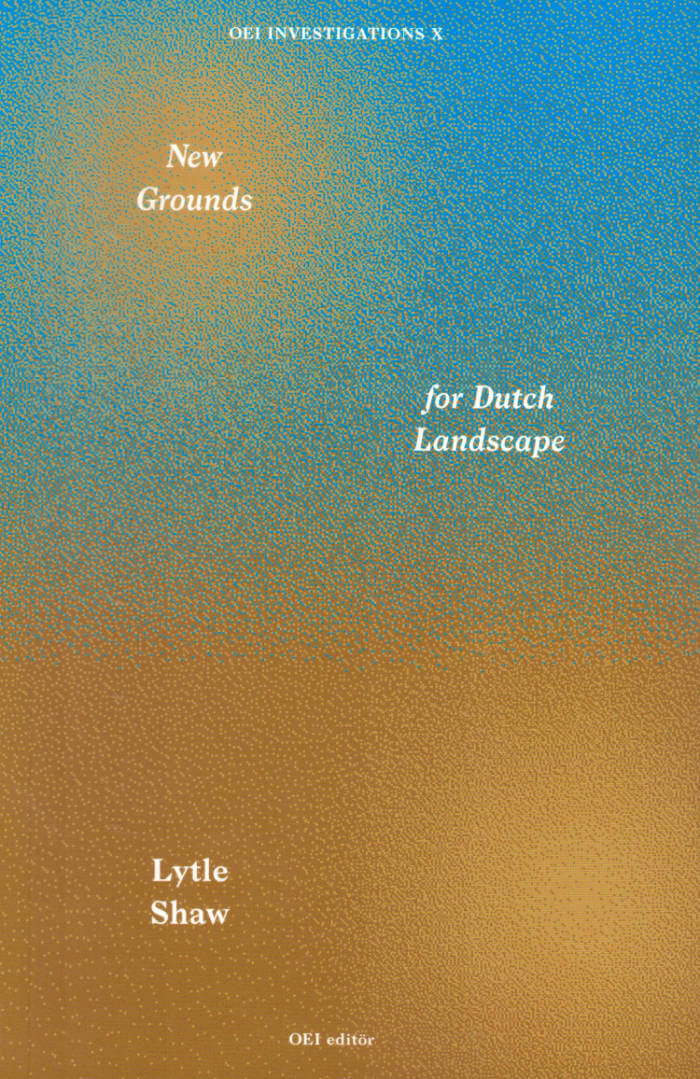
New Grounds for Dutch Landscape
New Grounds for Dutch Landscape uses an experimental, site-specific method to demonstrate how 17th century painters Jan van Goyen, Jacob van Ruisdael, and Meindert Hobbema did not so much represent the newly made landscape of Holland as reenact, through their painterly factures, its reclamation and ongoing threats to its stability: from flooding and drainage to abrasion and erosion.
These low-level dramas of recalcitrant matter allowed the Dutch to develop an ongoing temporality at odds with history painting’s decisive instant and a vocabulary of substance that wrested meaning away from humanist landscape painting’s expressive figures. — [publisher's note]
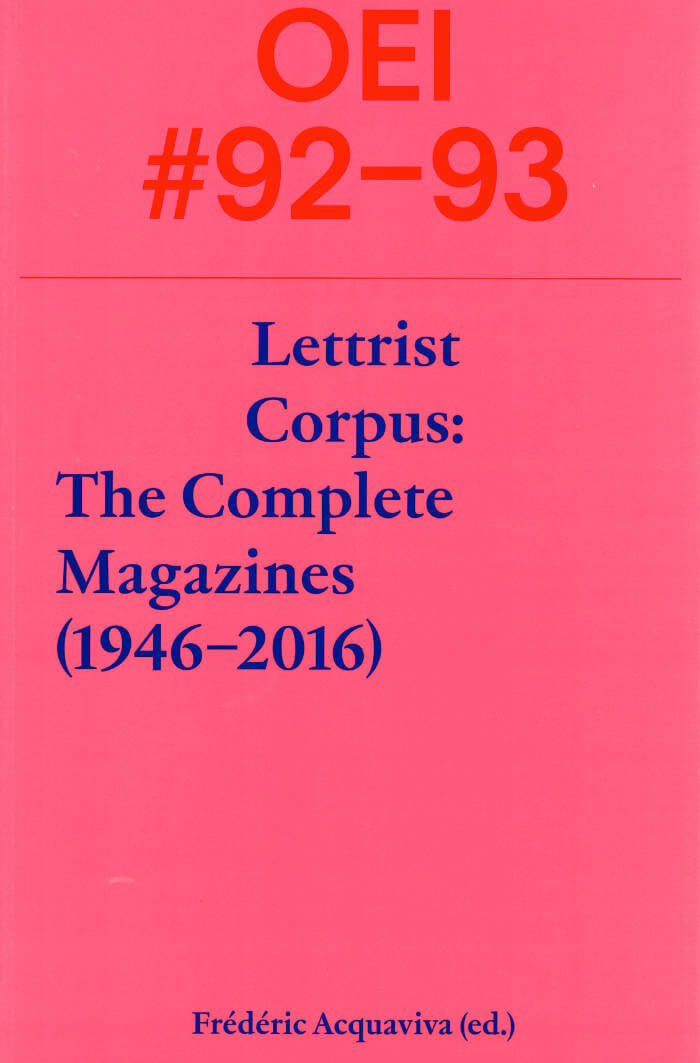
OEI #92-93 Lettrist Corpus: The Complete Magazines (1946–2016)
Frédéric Acquaviva, Jonas J. Magnusson and 1 more
“Un livre qui fera date. Deux ans de recherches, 512 pages, 1.361 illustrations en quadrichromie, 119 revues lettristes parues de 1946 à 2016 pour un total de 1.200 ouvrages décrits (avec la couverture et le sommaire de chaque numéro). Qui d’autre que les éditeurs suédois de OEI (Jonas J. Magnusson et Cecilia Gronberg) aurait pu sortir ce travail anthologique? Personne!” — www.mauricelemaitre.org
“The ‘unreasonable’ idea for this ‘catalogue raisonné’ came to me as an attemps to draw up a complete inventory of all the journals and periodicals of the Lettrist group, from its birth until today. Because the lifespan of the Lettrist movement has exceeded that of all the other avant-garde movements, we are undoubtedly in front of the most immense corpus ever produced in terms of magazines, coverin a period from 1946 to 2016. It presents more than a hundred different titles with more than one thousand items and hundreds of authors. . . . I hope that this comprehensive work will give the reader an opportunity to understand the different paths of the Lettrist groups and the many areas addressed, if not shaken, beyond the books of Isidore Isou and Maurice Lemaître. Since other Lettrists have published relatively few monographic books, and very little outside their own magazines, OEI #92-93 is a unique database for most of the Lettrist texts that we can access, also making it possible for new readers to come across Lettrism.”
— from Frédéric Acquaviva’s introduction
Design by Fält
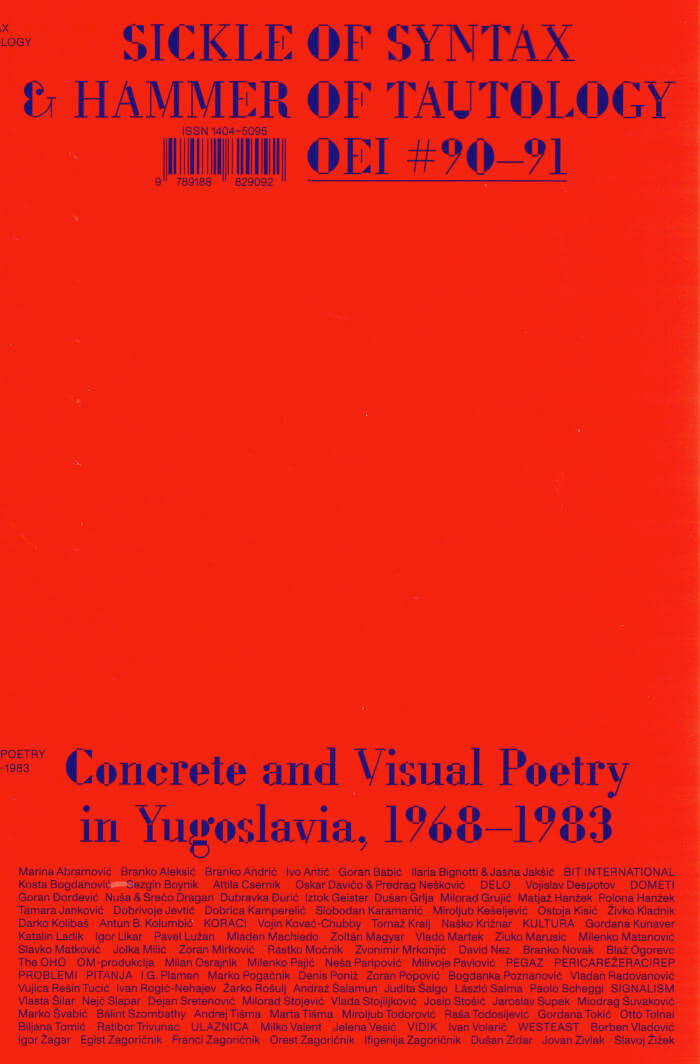
OEI #90/91 Sickle of Syntax & Hammer of Tautology
Tobi Maier, Cecilia Grönberg and 1 more
OEI # 90-91: Sickle of Syntax & Hammer of Tautology offers the first English language overview of the history of concrete and visual poetry production in socialist Yugoslavia between 1968 and 1983.
By focusing on mass-produced examples of concrete poetry, this publication presents these poetic experiments as organically linked to social movements, critical theories, and youth cultural revolutions. In his extensive introduction, Sezgin Boynik, the guest editor of this special issue of OEI, discusses concrete and visual poetry in socialist Yugo-slavia as an uneven and combined development, and emphasizes its confrontational and organizational aspects.
By means of interviews, translations, reproductions, and theoretical and historical statements, OEI # 90-91 offers a picture of a very lively scene of concrete and visual poetry in Yugoslavia, which unfortunately is not as recognized interna-tionally as it would deserve.
Hoping that OEI # 90-91 could contribute to this task in a substantial way, we present episodes from the early years of OHO formation and its complex theories of words and things; an interview with Rastko Močnik on programmed art and political formalism; militant polemics of Goran Babić; Signalist contradictions; subjective structural devices of Judita Šalgo; zaum experiments of Vojislav Despotov; detective meta-texts of Slavoj Žižek; poetic self-management studies of Vujica Rešin Tucić; a feminist historicisation of Ažin school for experimental poetry; democratisation of visual poetry by Westeast; selections from special issues of the journals Pitanja, Problemi, Ulaznica, Dometi, Delo, Koraci, Vidik, Pegaz, and many other materials translated here for the first time and presented in one publication.
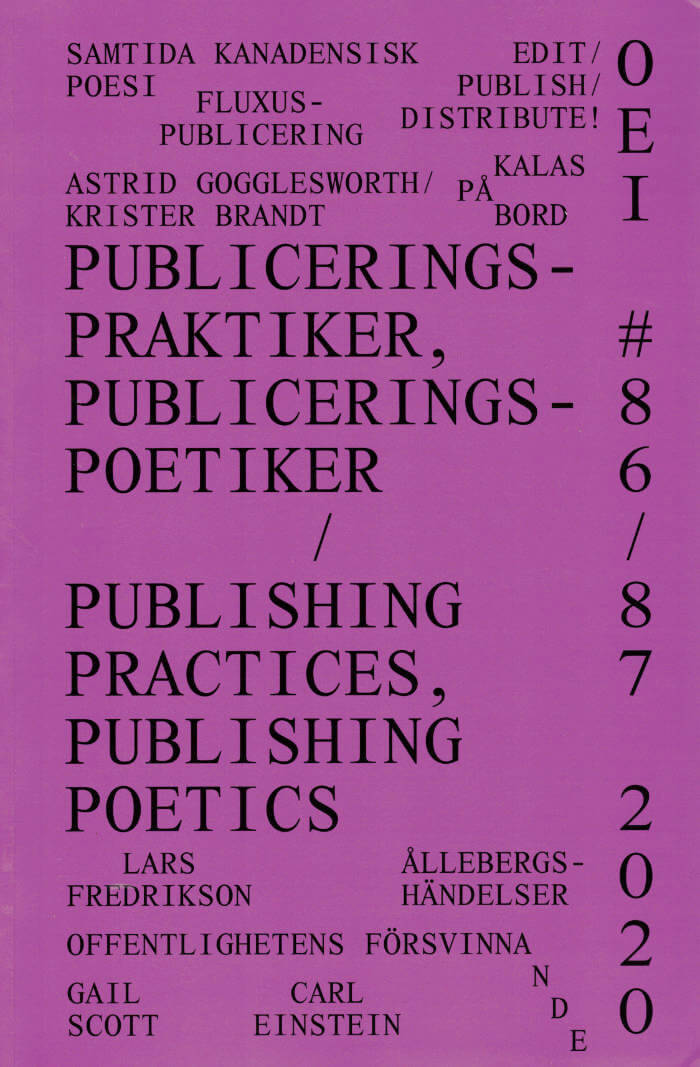
OEI #86/87 Publishing Practices, Publishing Poetics
Tobi Maier, Cecilia Grönberg and 1 more
Once more, an astonishing issue of OEI – a thrilling, compelling, stimulating feast of ideas regarding publishing and the book: the perfect big companion to read and hug in bed while the virus spreads outside.
Bringing together contributions from circa 130 publishing structures, publishing communities, magazines, small press endeavors, artists, poets, writers, editors, theoreticians, curators, scholars, and art bookstores, OEI # 86–87 reflects upon the challenges, pressures and possibilities of publishing and creating publics in different contexts and places in a time of far-reaching – economical, medial, political, social, technological – transformations.
The potential and the versatility of publishing open it to a diversity of practices and approaches in the arts, but as an eminently social form of art, a collective or micro-collective work with shared responsibilities, it is also a never-ending process of “crafting a variegated approach to how you create, publish, distribute, and build a social ecosystem around your efforts”, of trying to “build up and strengthen the community around these printed forms” (Temporary Services).
It is the conviction of OEI #86–87 that print has the power to play an important part in the construction of social spaces, of a social world. As Benjamin Thorel puts it in one of the essays in the issue, “conceiving of the dynamics of publishing as making publics as well as making things public is not a pun – insofar as the artists/publishers encompass, beyond the book itself, its possible ‘lives’, imagining the different spaces, and the different people, amongst whom a publication will circulate.” This is what Michael Warner has called “a public [as] poetic worldmaking”, implying “that all discourse or performance addressed to a public must characterize the world in which it attempts to circulate, projecting for that world a concrete and livable shape, and attempting to realize that world through address.”
This is also, as stressed by Annette Gilbert and others, what can make publishing such an active force, a force co-constituting texts and publications and publics. Indeed, with Michalis Pichler, it is tempting to say that in publishing as practice – perhaps more than in any other art field – “artists have been able to assert the aesthetic value of their own socio-politically informed concerns and to engage, often under precarious conditions, in cultural activities fully aligned with their political values.”
OEI #86–87 also includes sections on and with contemporary poetry from Canada; Fluxus publishing; Krister Brandt/Astrid Gogglesworth; Kalas på BORD (Öyvind Fahlström); Lars Fredrikson; Claude Royet-Journoud’s poetry magazines; Carl Einstein; Gail Scott; Ållebergshändelser; OEI #79: edit/publish/distribute!; “det offentligas försvinnande” and many many other things. [publisher’s note]
Design by Konst & Teknik